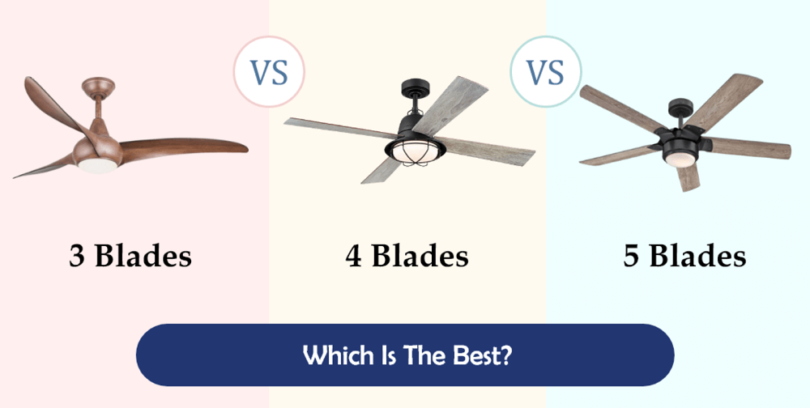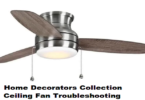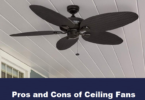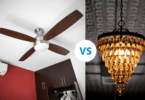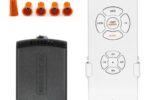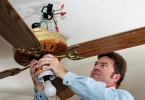Ceiling fans are available in different blade options – 3 blades, 4 blades, 5 blades, etc. Are you curious to know how many blades are best in a ceiling fan? Here is what you need to know.
When you read the benefits of ceiling fans, you will come to know why more house owners are willing to install ceiling fans in their homes and offices. It can be used as an alternative to ACs and it is the cheaper option and when they are used with ACs, they are very effective in terms of cooling of spaces and saving energy costs.
But it is not a child’s play to buy the right ceiling fan. When it comes to purchasing them, you need to consider different factors. Blade count is also one of them, i.e the number of blades a ceiling fan use. A lot of users get confused on this topic and they should be. If you have a look at the ceiling fan market, you will see all sorts of blade options in ceiling fans. The fans will be available with 2, 3, 4, or 5 blades. Take a closer look, and you will also find 6, 7, 8, or more blades on a single fan. You can also find 1-blade fans too.
So, it can make a person confused easily and the person asks, “how many blades should a ceiling fan have?”.
In this article, you will be able to get the answer to this question with our own opinion mixed with the opinions of experts that have been involved in the ceiling fans industry for a while.
So, let’s have fun and continue reading to solve the riddle. We will get the answer today.
Contents
“More Blades Mean More Airflow” – Is it true?
If you see two different ceiling fans one with three blades and other with five blades, you might think that the 5-bladed fan generates more air. However, this is not the case. We can say that it is one of the prominent misconceptions about ceiling fans.
Ideally, more blades should provide more air. But, a ceiling fan’s performance does not only depend on the number of blades, there are some other factors that play a vital role here; including shape, blade size, pitch, motor strength with other features.
And that can help the fan outrank a 5-blade ceiling fan with a 3-blade fan in terms of features. Modern ceiling fans are designed in this way to keep this balance. So, these days, we cannot say that more blades mean more airflow. On the other hand, the opposite can be true for some ceiling fans in the market. Nowadays, the difference in the number of blades on a ceiling fan focuses on aesthetics rather than performance, it is happening due to the huge amount of R&D that goes on in order to make these machines ideal.
The true fact is that there is a huge competition in the ceiling fan market. There is a popular saying, “Competition is good for customers” that is proven true in this market. It is due to the competitive market that pushed ceiling fan brands to go ahead of their limits. Consequently, they will construct good ceiling fans that can deliver good airflow whatever the blade count is. So, if you are getting your ceiling fan from a reputable brand of fan, to make sure that it will work fine regardless of the number of blades.
Here, we are going to add some quotes from experts in this industry and tell you what is their point of view about this subject:
Energy Star, the American official body that is focused on energy efficiency on customer’s products said this:
“Ceiling fans may have three, four, or five blades; but contrary to what you might expect, more blades do not move more air…”
Energy Star
Another quote from them is,
“In the past, ceiling fans were largely designed with 5 blades; however, today manufacturers are offering more efficient designs with 2, 3, and 5+ fan blades.”
Energy Star
Hunter Fan Company, another famous brand that has been producing ceiling fans for over 135 years says this,
“Blades can affect both the look and operation of a fan; however, that doesn’t necessarily mean that a 5-blade ceiling fan will perform better than a 3-blade ceiling fan.”
Hunter Fan Company
DelmarFans, is another famous website that is dealing with quality fans and lighting for the past 20 years,
“The difference between performance and noise level between ceiling fans with any number of blades is negligible… it is more of an aesthetic choice.”
DelmarFans
These sources are very authoritative in this industry.
3 Blade vs 5 Blade Ceiling Fan – How To Compare Them?
After reading the previous sections, you can say that blade count has no effect on the ceiling fan’s performance, let’s have a look at some examples available in the below table.
| Model | Number of Blades | Blade Span (in Inches) | Wattage | CFM (Cubic Feet per Minute) | Efficiency | EnergyStar Rating? |
| Minka-Aire Sleek – LED 60-inch Smart Ceiling Fan | Three | 60” | 17 | 3478 | 205 CFM/W | Yes |
| Minka-Aire Watt – 60-inch Ceiling Fan | Five | 60” | 21 | 4407 | 206 CFM/W | Yes |
| Modern Forms WYND 52-inch Smart Ceiling Fan | Five | 52” | 21 | 4286 | 207 CFM/W | Yes |
| Modern Forms Vortex 60-inch Smart Ceiling Fan | Three | 60” | 23 | 4642 | 202 CFM/W | Yes |
| Westinghouse Morris 52-inch | Five | 52” | 38 | 3316 | 88 CFM/W | No |
| Westinghouse Alta Vista 52-inch Ceiling Fan | Three | 52” | 40 | 3334 | 84 CFM/W | No |
| Kichler Link 54-inch 2 Blade Ceiling Fan | Two | 54” | 21 | 3926 | 184 CFM/W | Yes |
| Progress Lighting P2570-143 56-inch Ceiling Fan | Two | 56” | 21 | 4497 | 215 CFM/W | Unknown |
*All the stats available in the columns including Wattage, CFM, and Efficiency are based on typical use, excluding lighting fixture, and are given by the respective manufacturers.
These fans contain a different number of blades but still there is a hardly a prominent difference between them (you can check CFM, Efficiency columns to find out).
However, the number of blades hardly impact the performance, it does not indicate that it will not make any difference at all. In fact, there are few differences between three blade ceiling fans and 5 blades ceiling fans apart from their performance. Here is a chart to show that:
| 3 Blade Ceiling Fan | 5 Blade Ceiling Fan |
| They are cheaper | They are more expensive |
| Fewer parts, lesser maintenance | More parts, more maintenance |
| Less heavy, less pressure on the motor | Heavier, more pressure on the motor |
| Energy efficient | Consume more energy |
| Offer trendy/modern looks | Offer more traditional looks |
| A little noisier | Are quieter |
| More Airflow in a gushing form | Additional breeze gentle in nature |
As you can see, in this modern age, 3 blade ceiling fans are a better option as compared to 5-blade fans.
When discussing 4 blade ceiling fans, it will be safe to conclude that they will be somewhere between these two choices.
When to Choose and Which Type to Choose?
I think, at this, point, you will be able to get a general idea of when to choose a ceiling fan and what type to choose:
- Choose a 3-blade ceiling fan if you prefer a simple and sleek design, and don’t be annoyed by a little bit of gushing airflow (it does not happen always). This type of a fan will add beauty to your modern décors.
- Choose a 5-blade ceiling fan if you give preference to a traditional style and gentle breeze, and do not overthink about the extra weight and perhaps price of this type of unit. This type of fan will boost your rustic décors gracefully.
- Choose a 4-blade ceiling fan if you prefer both of the previous options and remain between them.
Which Is More Popular – 3 Blade Fans or 5 Blade Fans?
There are different ways to as this question, for instance, “Which is more beautiful?”. Well, the answer to this question depends on you. Whatever looks beautiful to you will be considered beautiful. As the famous quote, “Beauty is in the eye of the beholder”?
But if you ask us, which is more popular whether they are 3 blade fans or 5 blade ones?
A 5 blade fan is traditionally considered as the standard of a ceiling fan, but when you analyze the current market of ceiling fan, you will see a completely different picture. People these days are considering simple and sleek designs. So, 3 blade ceiling fans are taking over the market, leaving their 4 and 5 bladed counterparts behind.
We will show you two graphs in order to prove this statement.
Here is the first graph:
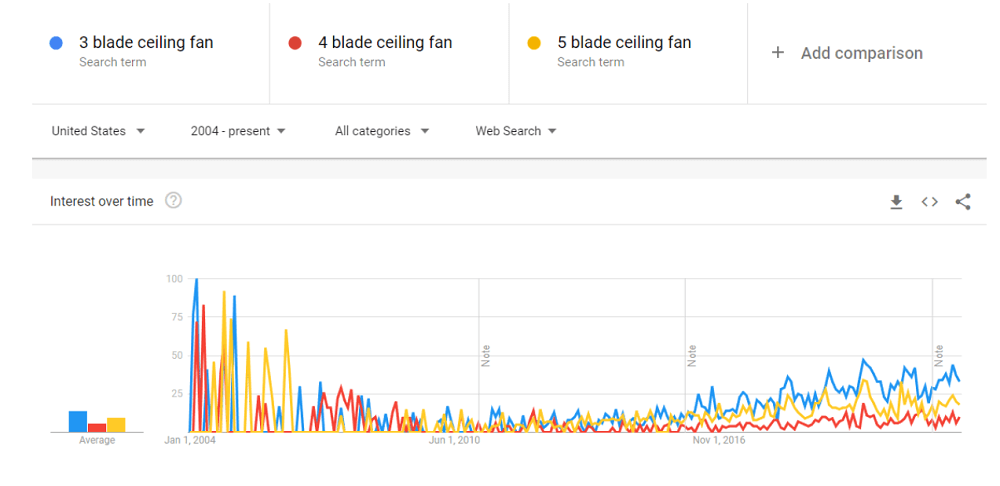
3 blade, 4 blade, and 5 blade ceiling fan popularity which we source from Google Trends
This graph shows the Google trends which includes terms “3 blade ceiling fan” “4 blade ceiling fan”, and “5 blade ceiling fan” in the US ranges from 2004 to October 2022. If you are not aware of it, Google Trends shows the popularity of a term which is determined by the number of searches that term gets from users from Google Search. This picture tells the story that all three options were fighting against one another around 2010, 3-blade option is clearly taking over in 2022.
Here is another picture:

It shows 3 blade, 4 blade, and 5 blade ceiling fan demand
This screenshot is taken from Keywords Everywhere tool to show the search volume for these terms specifically in the united states. If you are not aware of it, search volume means the average searches a keyword receives every month, in this case (last 12 months). This graph is also an indication that the trend for ceiling fans is clearly moving toward the 3-blade option.
CFM: To Guarantee Great Airflow When Buying A New Fan
As we have already discussed a lot of things impact on the ceiling fan’s performance including blade size, pitch, shape and motor power. You will be able to enjoy the best airflow when you get the best balance between them. But do you have any idea whether your ceiling fan contains this balance or not?
CFM is a number that explains the good or bad performance of a ceiling fan. CFM is a short form of Cubic Feet Per Minute, which shows the power of a ceiling fan put every minute, and this measurement is done on its highest setting. Then it is divided by the watts the fan uses, and you will get the final CFM/W measurement. The more the CFM/W it has, the better the fan is.
EnergyStar requirement about a CFM/W of 36-78 inch ceiling fan which is a standard size has to fulfill the formula (2.63*D – 26.83), in which D indicates the blade span in inches, to make it efficient. So, a 52-inch ceiling fan must generate a minimum of 100 CFM/W airflow or more than that. In general, a good energy-efficient ceiling fan offers a much higher CFM/W than this.
So, when you make your mind for your next ceiling fan, you need to make this number more competitive. Generally, you do not have to consider much about blade pitch, shape, motor strength and other related technical terms. The only thing useful for you is the CFM/W. Make sure this number is good enough, and you will get the best airflow with your model, regardless of the number of blades.
User Feedbacks
In this portion, you will see some 2 and 3-blade ceiling fans and show the feedback from real users, what is their point of view in terms of performance, to prove that all good ceiling fans generate good airflow, regardless of how many blades one is equipped with.
1. Here is an example of 2-bladed Minka Aire F846-DRF, Wave II 60″ model:
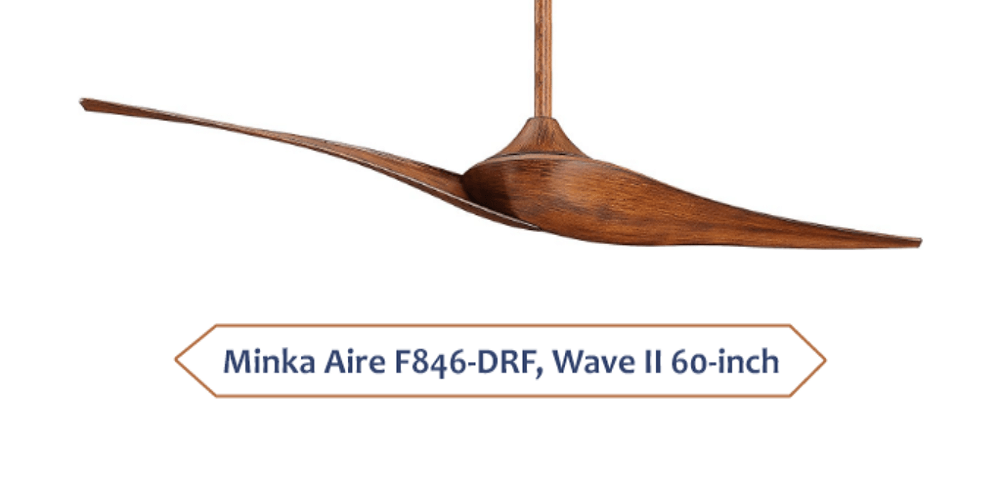
And here are some of the feedbacks from real users about its airflow:
- “…it moves a TON of air…”
- “…It has good enough air when on the first setting that we don’t need to turn it up…”
- “Am very happy with the item works quietly, moves a lot of air…”
2. And this is a 2 blade ceiling fan, the Progress Lighting P2570-143 56” model:
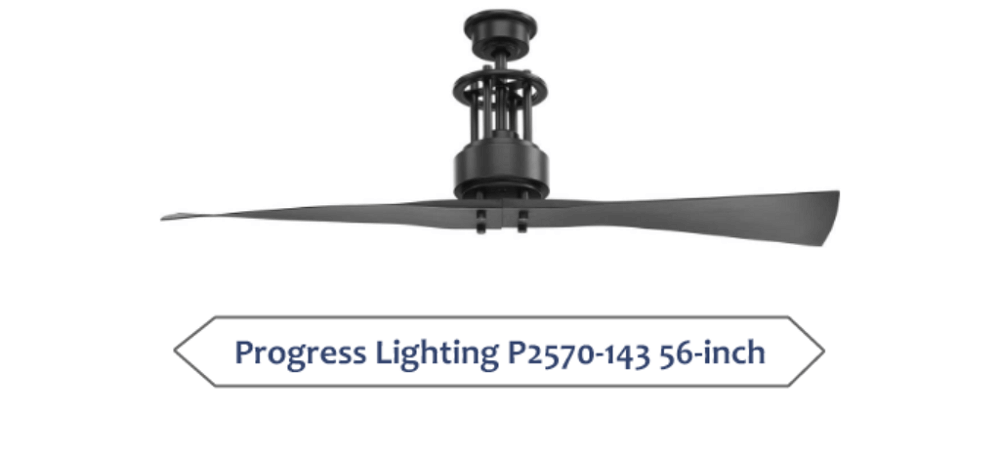
And here are what some of the user reviews:
- “It generates more air with its unique looks”
- “…moves a lot of air and has many speed settings to use.”
- “Fantastic. These fans really move the air and are extremely quiet.”
3. Here is an example of a 3-bladed fan, the Minka-Aire Light Wave 52″ model:
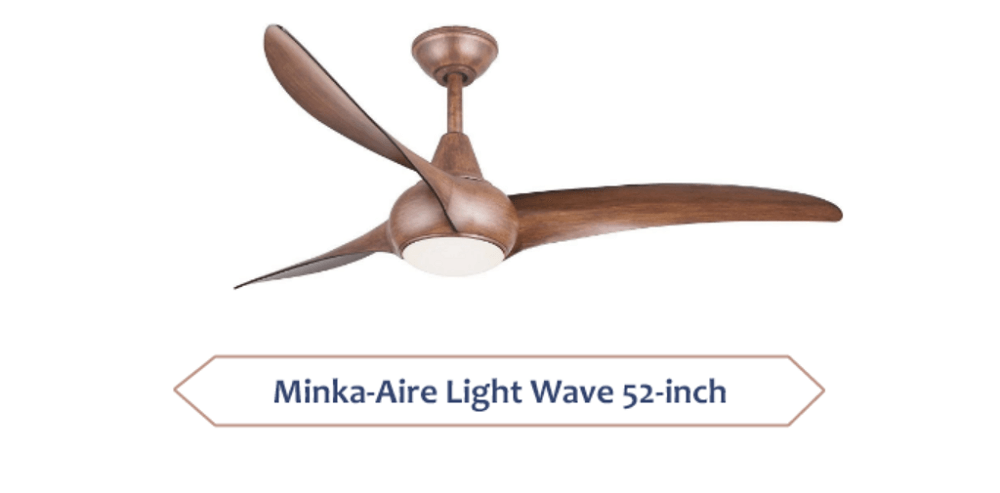
And here’s some reviews from the real buyers in terms of performance:
- “…Moves a lot of air and is seriously nearly SILENT on high speed!”
- “…It does move air well.”
- “Very stylish fan that moves significant amount of air even on low setting”
4. And the last example is, the Hunter Symphony Indoor 54” model:
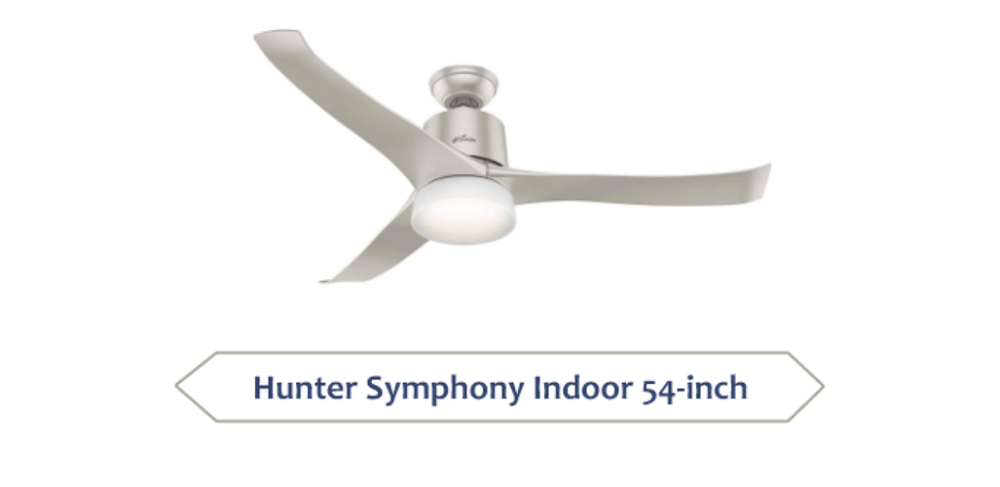
And here’s the real customers tell us about its performance:
- “Very quiet. Lots of air…”
- “It moves enough air at the lowest speed, so I don’t see why you would need to crank it up…”
- “the amount of air that it moves is staggering!..”
- “Moves the air better than the 5-blade fan that was removed.”
P.S. We did research and gathered these feedbacks from Amazon at the time of writing this article. So, you can also read them there in order to verify it.
So, the question is do 3 blade ceiling fans work well?
Absolutely yes!
How Many Blades Should a Ceiling Fan Have?
If you prefer performance, then all ceiling fans can function great if you purchase them from a reputable brand. The only thing to ensure is a satisfactory CFM/W rating.
If you prefer looks, whatever attracts your eyes is ideal. The current market is focused on 3-blade options; keep it in mind too. But 2-blade ceiling fans are also very prominent in the market.
However, if you are the owner of a traditional style home, a 5-blade fan of the same design will be an ideal option for you, introducing an antique vibe to your home décor. Lastly, it also depends on your situation as well. We cannot finalize one size for every space.
What’s Next?
Do you want to know if ceiling fans are dangerous? Learn here. Ceiling fans can also be used in the winter season as well. To use them in winter, use ceiling fan reverse direction. Also, learn about the pros and cons of ceiling fans. In the last section, we said that you should prefer a reputable brand when it comes to getting a ceiling fan. here are our recommendations from Kichler, Hunter, Minka-Aire, Quorum International, Honeywell, Emerson, Harbor Breeze, and Craftmade.
Since you are getting the new ceiling fans, you may want to remove the old unit, right? Here is how to take it down, and clean them with some helpful tips.

